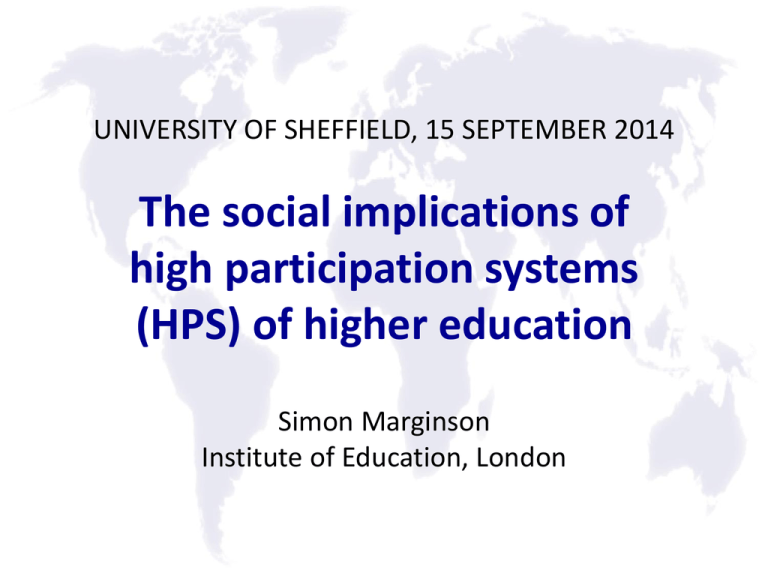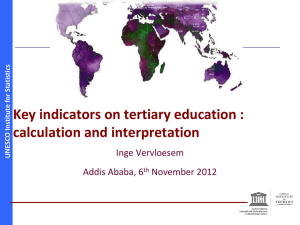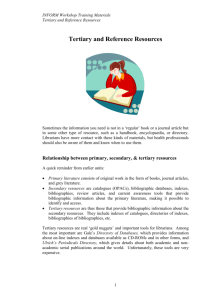Simon Marginson`s Slides - University of Sheffield
advertisement

UNIVERSITY OF SHEFFIELD, 15 SEPTEMBER 2014 The social implications of high participation systems (HPS) of higher education Simon Marginson Institute of Education, London THE ACCELERATING GROWTH OF PARTICIPATION IN TERTIARY EDUCATION Gross Tertiary Enrolment Ratio (GTER) (%) world regions, 1995/2011 UNESCO Institute for Statistics data 2014 North America & Western Europe 77 60 Central & Eastern Europe 68 33 La n America & Carribean 42 17 East Asia & Pacific 30 10 24 Central Asia 23 Arab States 23 14 South & West Asia 18 6 Sub-Saharan Africa 4 8 WORLD 30 15 0 10 20 2011 30 40 1995 50 60 70 80 90 Gross Tertiary Enrolment Ratio 1995/2011 Selected OECD and European systems, UNESCO Institute for Statistics data 2014 GTERs in East Asia & Singapore 2011 (%) UNESCO Institute for Statistics & Taiwan Ministry of Education South Korea Taiwan Macau SAR Hong Kong SAR Japan China Vietnam Singapore 101 84 64 60 60 24 24 Data not available WORLD 30 0 20 40 2011 60 1995 80 100 120 Regional variation in GTER (%) in China Gross Tertiary Enrolment Rate, 2010. Source: Po Yang, Peking University Beijing 60 Shanghai 60 45 Zheijiang 40 Jiangsu 28 Guangdong 25 Sichuan 18 Yunnan 15 Tibet 0 10 20 30 40 50 60 70 GTERs Latin America & Caribbean 2011 (%) UNESCO Institute for Statistics data 2014 GTERs in South Asia 2011 (%) UNESCO Institute for Statistics data 2014 GTERs in Africa 2011 (%) UNESCO Institute for Statistics data 2014 No data for Botswana, Lesotho, Nigeria, Sierra Leone, South Africa, Tanzania, Zambia. Data for Cote d’Ivoire and Senegal 2010. Data for Kenya 2009. Data for Nambia 2008. North Africa not included. Not all Sub-Saharan Africa included WHAT ARE THE DRIVERS OF PARTICIPATION GROWTH? Economic development? Labour markets? States? Popular demand? Driven by the economy? • In the last 25 years the tendency to expansion of participation in tertiary education (albeit in fits and starts), and acceleration of growth since the late 1990s, has been near universal in countries with over $3000 USD per capita. It seems independent of economic growth rates (high, medium or low) • Human capital theory and equality of opportunity are policy rationales for the expansion of participation, they are not drivers • While economic demand fosters expansion of student places in particular fields short of labour (e.g. mining engineers in a mining boom), there is no clear evidence economic demand consistently drives participation growth. The relationship between higher education and the economy is incoherent: o many graduates do not work in fields in which they are trained. This is not a pathology, it is the way labour markets work. Note that much graduate labour is generic in character o phenomena such as crendentialism, signalling behaviour and graduates working in nongraduate jobs seem at least as prominent as the expansion of high-skill work o there is no guarantee graduates generate higher productivity—that is a function of work organization o the perennial debate about over-education versus overall shortage of skills is never settled. Neither generalization holds, education/economy relations are not direct or instrumental Social demand or economic demand for higher education? Which is the more plausible explanation of growth? I say growth is fully explained by ECONOMIC demand. Don’t listen to Marginson! Gary Becker, author of Human Capital (1964) Martin Trow and the social drivers of participation • ‘There will be continued popular demand for an increase in the number of places in colleges and universities. It seems to me very unlikely that any advanced industrial society can or will be able to stabilize the numbers’ • Despite ‘loose talk about graduate unemployment or of an oversupply … it is still clear that people who have gone on to higher education thereby increase their chances for having more secure, more interesting, and better paid work throughout their lives’ • Graduate unemployment is not a problem because of the ‘educational inflation of occupations’ (Trow, 1974, pp. 40-41) Urbanization and the GTER Proportion of population living in urban areas (%) and Gross Tertiary Enrolment Ratio (%), World’s 20 largest nations by population, arranged in order of intensity of urbanization, 2011 GTER data not available for Brazil, Nigeria, Philippines and Ethiopia Growth of tertiary participation faster than GDP per capita, China 1980-2012 Growth of tertiary participation and GDP per capita, Korea 1980-2012 States enable and faciliate the take-off of participation, but do not reverse it Growth in participation to come Asian middle class 2009-2030 (millions), Brookings / OECD 2010 4000 3228 3000 2000 1740 1000 525 0 2009 2020 2030 Middle class persons are defined as persons living on USD $10-100 per day, PPP STRATIFICATION OF HPS HOW UNIVERSAL? DRIVERS? 1. Global stratification 2. Within national HPS Shanghai Academic Ranking of World Universities top 200, 2014 China, 6 Hong Kong, 2 Singapore, 2 Japan, 8 Israel, 4 Saudi Arabia, 2 other Asia, 2 La n America, 2 other Europe, 6 Denmark, 3 USA, 77 Belgium, 4 Sweden, 5 Italy, 6 Switzerland, 7 Netherlands, 8 France, 8 Germany, 13 UK, 20 Canada, 7 Australia, 8 51 countries with 1000 science papers p.a. US National Science Foundation data for 2011 ANGLOSPHERE EUROPE EU NATIONS EUROPE NON-EU ASIA LATIN AMERICA Australia Austria Italy Croatia* China Argentina Canada Belgium Netherlands Norway India Brazil N. Zealand Czech Rep. Poland Russia Japan Chile* UK Denmark Portugal* Serbia* Malaysia* Mexico USA Finland Romania* Switzerland Pakistan* M.EAST /AF France Slovakia Turkey Singapore Iran Germany Slovenia* Ukraine South Korea Israel Greece Sweden Taiwan Saudi Arab.* Hungary Spain Thailand* Sth. Africa Ireland Sweden Egypt Tunisia* * Reached 1000 papers since 1997 (11 out of 51 nations) Nations publishing more than 1000 journal papers in science, 2011 Bourdieu and the bifurcation of national systems From access? to access to what? •Not all systems are stratified to the same extent or in the same ways •A sometimes large middle layer of HEIs complicates Bourdieu’s picture WHAT IS A HIGH PARTICIPATION SOCIETY?











